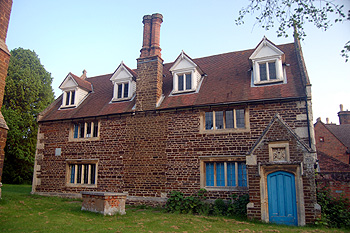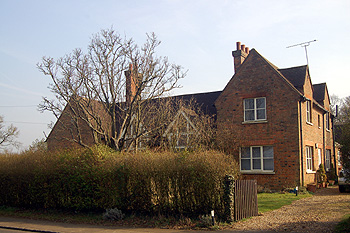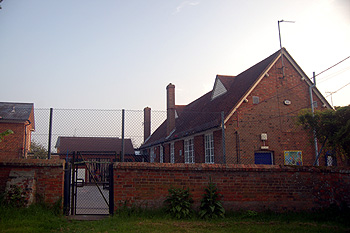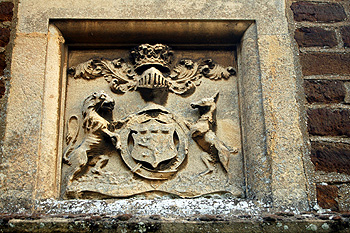19th Century Education in Woburn

The old school building at Woburn May 2012
At the beginning of the 19th century the schoolmaster’s stipend was worth £35 a year and the master taught 35 boys reading, writing and accounts. In 1808 the schoolhouse was repaired and the school reorganised under the Lancasterian System (after Joseph Lancaster, a Quaker, who founded an elementary Free School in Southwark [Surrey] in 1798), where as well as the headmaster, the older pupils helped teach the younger ones [W1/851852]. This system was encouraged by the British and Foreign Schools Society so after that the school became known as the British School. British Schools tended, though not exclusively, to be of nonconformist persuasion; their Anglican equivalents were known as National Schools. At Woburn there were 150 boys divided into 8 classes, each class taught by a monitor and his assistant, with the master overseeing them all. From 1808 the master's stipend was raised to £50 per annum. Stephen Dodd in his 1818 Account of the Town of Woburn states that about another £50 was “raised in the town”. The Duke of Bedford continued to maintain the school premises. Dodd noted that the schoolhouse was “large … of stone, three stories in height, containing two large schoolrooms, besides many other apartments”.
In 1818 a Select Committee was established to enquire into educational provision for the poor. This was no doubt prompted, in part, by the recent foundation of two societies promoting education and specifically the building of schools - the British Schools and National Schools referred to above. The Select Committee sent a questionnaire to all parishes in the country asking for: particulars relating to endowments for the education of children; other educational institutions; observations of parish needs etc. The Free School is duly noted in this survey. Also noted on the survey is a lace-making school for 61 children and also a sewing school on Saturday afternoons for 82 girls. In addition there was an Anglican Sunday School for 66 children and one "belonging to the Dissenters" attended by 56 children. It should be noted that these Sunday Schools were just that, schools held on a Sunday, at which subjects such as writing were taught in addition to the religious instruction with which they are synonymous today. As a result of all these various schools the Vicar, Rev. John Parry was able to record: "When the poor are desirous of education, every facility is afforded them".
J. D. Parry in his book Woburn and Its Abbey published in 1831 says that: “in the year 1825, a school for girls was established, under the patronage of the Duke and Duchess of Bedford, in which the scholars are also instructed in needlework and in the manufacture if Tuscan plait”. A girls’ school had been proposed in 1813 and its rules set out [R4/608/35/9-11], evidently this came to nothing at the time. In the same year the revised rules for the Free School and Sunday Schools were drawn up, a draft being as follows [R4/608/35/14]:
1. No child to be admitted that has not had the smallpox, or been vaccinated, or whose parents will not undertake and cause that the child shall be vaccinated within three months from its entering the school and subscribers are requested to make the enquiry before recommending scholars for admission.
2. The children must by their parents be sent in a decent state – their hair cut and combed and hands and face clean washed and on [sic if] any children be otherwise the master shall send to the parent a copy of this Order, a request to attend to it and in case of inattention to his request he is to inform the Committee that they may take measures accordingly and expel the boy from the school if requisite.
3. On the admission of children to the school the master or mistress shall by them send these Resolutions to their parents with a request that they may be perused and attended to.
4. In case of irregular attendance of any scholar, the master or mistress shall enquire the cause and, in writing, inform and admonish the parents according to a form prescribed and without a satisfactory cause for their absence be shewn they will be struck off the list and excluded the benefit of the institution.
5. Any boy who shall have regularly attended to his education for three years and shall quit the same for such employment as the Committee may approve and having conducted himself to their satisfaction he shall from them receive a character accordingly and some other token of their approbation.
6. All children attending the day school shall, on every Sunday, also attend church or some other place of worship as their parents may approve unless particular circumstances may require them elsewhere.
7. On Whit Monday in every year the children who behave well shall break up and parade the town and receive some refreshment.
In the country generally the number of schools built continued to grow over the next fifteen years so that by 1833 the government agreed to supplement the work of the two societies, and local benefactors, by making £20,000 per annum available in grants to help build schools. It also prompted another questionnaire to be sent to each parish in England asking for details of local educational provision. It was recorded that Woburn had two daily Lancasterian schools, one for 131 boys and the other for 71 girls (which began in 1825). The master's salary was now £70 per annum whilst the mistress of the girls' school received £40, partly from subscriptions and partly from payments by parents. At this stage both boys and girls were taught in the same premises, the original school of 1582. In addition there were four boarding schools, two containing 50 boys and the other two 41 girls, respectively, all educated at parental expense.

The former Boys' School in Leighton Street March 2012
In 1845 the Duke donated land for the opening of a two new schools. Woburn British Boys’ School was built in Leighton Street [R3/4961] and is now a private house. Woburn British Girls’ School was built at right angles to the old Free School of 1582 and today [2012] forms part of Woburn Lower School. The old Free School building (“sadly dilapidated” [R3/4951]) was used as Woburn British Infants’ school; again today it is part of Woburn Lower School.

The former Girls' School buildings May 2012
The Duke took great interest in the schools, and an old Russell family trust fund provided prizes, school fees and apprenticeships for the children. The cost of sending boys to the new school was about 3d. a week, but richer parents were expected to pay a lot more. Most children left school when they were 12 or 13, but some of the boys at Woburn stayed on until they were 15. They were all taught reading, writing and arithmetic of course, but also music, singing, scripture studies, drawing, dictation, geography, history, algebra, geometry, science (including astronomy and electricity) and grammar. The boys also played football, and some did “domestic economy” and, later on, gardening. After 1891 education was free.

The Bedford arms over the door into the old school at Woburn May 2012
At the same time as the 1851 census an educational census was held and Woburn recorded four evening schools for adults in the district (not necessarily all in Woburn itself) and which 74 men and 39 women received education. Furthermore Woburn had a Literary & Scientific Institute with 62 men and 5 women as members; it had an impressive library of 330 volumes and met monthly. Bedfordshire & Luton Archives & Records Service also has an advertisement of 1850 for Edward Henrie's Classical, Mathematical & Commercial Academy
Education was also dispensed at the workhouse. Woburn was the centre of a Board of Guardians District serving a number of other neighbouring parishes (at this date Aspley Guise; Aspley Heath; Battlesden; Chalgrave; Eversholt; Harlington; Hockliffe; Hulcote; Husborne Crawley; Milton Bryan; Potsgrove; Ridgmont; Salford; Tilsworth; Tingrith; Toddington; and Woburn itself). The union workhouse ran a school which, on 13th March 1848 contained 23 boys and 19 girls, the latter having their own schoolroom whilst the former were taught in an ante-room by the porter. The discipline was recorded as "apparently good", instruction, not surprisingly, as "very deficient"; it was noted: "This school is subject to all the usual inconveniences of small workhouse schools". By October of that year, boys were being sent to the Free School whilst the girls continued to be taught in the workhouse schoolroom, the education being "slightly improved". An inspection in 1857 revealed 14 boys and 23 girls and infants receiving education, the boys were now, again, taught in-house by a mistress formerly at Ampthill Parochial Union School. The inspector remarked "The boys were, till her appointment, instructed in the Free School, and whenever I examined I was struck by their ignorance and want of intelligence. The contrast they now present is a remarkable exemplification of the truth, that the school is the reflection of the teacher".
Around this time investigations were being made of the effect that earning a living was making on children's education and in 1864 J. E. White investigated the straw plait and bonnet trade in this respect. A letter from Henry Veasey of Woburn, medical officer to the workhouse, gives a graphic, though balanced, idea of what this involved:
"Your inquiry respecting straw plait schools has awaited reply to admit of further observations”.
“The district immediately adjacent is not manufacturing, and young children are engaged in the plait under cottage teachers. The work is wholly voluntary, and rather resembles a plain working school. Overcrowding prevails occasionally, but as plaiting admits of out-door exercise, the children commonly execute much work as they walk in the open air”.
“Excoriated mouths, chiefly at each angle, are common, from a practice of drawing the straws through the mouth, and a weakly attenuated aspect may arise from this habit, and partly from bad air. Brimstone and vitriol are, I believe, used to prepare the straws, possibly something worse”.
“Regretting to serve the cause of humanity so feebly, I am &c…"
At the new school buildings all was not necessarily rosy; the headmaster thought the rooms stuffy, probably because they were heated by open fires and the windows were jammed shut. The playground was in poor condition in 1863. A gas supply was laid on in 1898. Children stayed away from school with illnesses like measles, mumps, coughs, colds, influenza, scarlet fever and once in 1863 there was a case of smallpox. Other things occurred occasionally: in 1888 one boy “had a bad head – Ringworm” and was off school for months, another was sent home “to be made clean”. The school logbook notes some other reasons than straw plaiting for absences [SDWoburn1/1]
- 17th November 1863: "Rifle shooting, many boys absent";
- 11th December 1863: "Hounds meet at Woburn Abbey. half yearly sale of fat stock at the Park Farm. Very few present";
- 11th October 1864: "Great Drakelow Pond fished. Very short attendance p.m.";
- 13th December 1865: "Many absent at the Great Pond Fishing, Woburn Park in the afternoon".
Discipline was not severe at Woburn school and the cane was not often used, but there were some troublesome families. In 1864 the school log book records, “The Robinsons caned. C. Robinson escapes through window” [SDWoburn1/1]. Perhaps a case for punishment might have arisen from this entry of 27th October 1864: "In consequence of the dirty state of the playground the Boys play out in the fields too much. Am afraid of complaints about broken fences. Wish for fine weather and a football". This materialised in December as this entry for 15th reveals: "The football this week has cured hedge-hopping and late attendance p.m.".
The first Education Act was passed in 1870 (more correctly it was known as the Elementary Education Act). It was a milestone in the provision of education in Britain demonstrating central government's unequivocal support for education of all classes across the country. It also sought to secularise education by allowing the creation of School Boards. These were groups of representatives, elected by the local ratepayers and the Board had the powers to raise funds to form a local rate to support local education, build and run schools, pay the fees of the poorest children, make local school attendance compulsory between the ages of 5 and 13 and could even support local church schools, though in practice they replaced them, turning them into Board run schools (known as Board Schools). Naturally, and luckily for local historians, the Act required a questionnaire of local schools in 1870; that for Woburn revealed that the British School had room for 132 boys, 117 girls and 125 infants.
As a result of a ratepayers’ petition of December 1872 a public meeting was held in the Town Hall on 3rd February 1873 at which it was agreed to form a School Board. On 12th February 1873 the School Board was elected (only the seventh in the county to date), and the former British School thus became known as Woburn Board School. Original board members were: Rev. Samuel Francis Cumberlege (the vicar); Rev. James Andrews (Congregationalist minister); Z. Phillips; J. Gilby and J. Sergeant.
A general meeting of the subscribers was called on 5th May 1873 to transfer management of the schools to the Board. On 5th August 1873 the Duke of Bedford leased the Boys’ and Girls’ School premises to the Woburn School Board [SB51/2-3]. On 7th December 1874 the trustees of the Free School leased their building to the School Board for one shilling per annum rent; later this lease was transferred to Bedfordshire County Council and a new lease of 1949 raised the rent to £52 per annum! Religious instruction continued to be given by the teachers in the board schools from 9.10 a.m. to 9.45 a.m. each day.
Since the original endowment of the Free School could no longer be applied to its proper purpose, in 1875 the Duke of Bedford commuted the £10 rent charge for a money payment which was invested by the trustees in £333/12/6 consolidated stock. With the sanction of the Charity Commissioners income derived from this investment was used to pay school and apprenticeship fees and for rewards to Board School children.